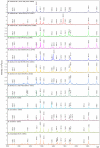Identification of Brucella by MALDI-TOF mass spectrometry. Fast and reliable identification from agar plates and blood cultures
- PMID: 21151913
- PMCID: PMC2997794
- DOI: 10.1371/journal.pone.0014235
Identification of Brucella by MALDI-TOF mass spectrometry. Fast and reliable identification from agar plates and blood cultures
Abstract
Background: MALDI-TOF mass spectrometry (MS) is a reliable method for bacteria identification. Some databases used for this purpose lack reference profiles for Brucella species, which is still an important pathogen in wide areas around the world. We report the creation of profiles for MALDI-TOF Biotyper 2.0 database (Bruker Daltonics, Germany) and their usefulness for identifying brucellae from culture plates and blood cultures.
Methodology/principal findings: We created MALDI Biotyper 2.0 profiles for type strains belonging to B. melitensis biotypes 1, 2 and 3; B. abortus biotypes 1, 2, 5 and 9; B. suis, B. canis, B ceti and B. pinnipedialis. Then, 131 clinical isolates grown on plate cultures were used in triplicate to check identification. Identification at genus level was always correct, although in most cases the three replicates reported different identification at species level. Simulated blood cultures were performed with type strains belonging to the main human pathogenic species (B. melitensis, B. abortus, B. suis and B. canis), and studied by MALDI-TOF MS in triplicate. Identification at genus level was always correct.
Conclusions/significance: MALDI-TOF MS is reliable for Brucella identification to the genus level from culture plates and directly from blood culture bottles.
Conflict of interest statement
Figures


References
-
- za J, Gudiol F, Pallares R, Viladrich PF, Rufi G, et al. Treatment of human brucellosis with doxycycline plus rifampicin or doxycycline plus streptomycin. A randomized, double-blind study. Ann Intern Med. 1992;17:25–30. - PubMed
-
- Solera J, Rodríguez-Zapata M, Geijo P, Largo J, Paulino J, et al. Doxycycline–rifampin versus doxycycline–streptomycin in treatment of human brucellosis due to Brucella melitensis. The GECMEI Group. Grupo de Estudio de Castilla-la Mancha de Enfermedades Infecciosas. Antimicrob Agents Chemother. 1995;39:2061–2067. - PMC - PubMed
-
- Colmenero JD, Reguera JM, Martos F, Sánchez de Mora D, Delgado M, et al. Complications associated with Brucella melitensis infections: a study of 530 cases. Medicine (Baltimore) 1996;75:195–211. - PubMed
-
- Ariza J, Corredoira J, Pallares R, Villadrich PF, Rufi G, et al. Characteristics of and risk factors for relapse of brucellosis in humans. Clin Infect Dis. 1995;20:1241–1249. - PubMed
-
- Lindquist D, Chu MD, Probert WS. Francisella and Brucella. In: Murray PR, Baron EJ, Jorgensen JH, Landry ML, Pfaller MA, editors. Manual of Clinical Microbiology (9th ed.) Washington, DC: American Society for Microbiology; 2007. pp. 815–834.
Publication types
MeSH terms
Substances
LinkOut - more resources
Full Text Sources
Medical
Molecular Biology Databases

